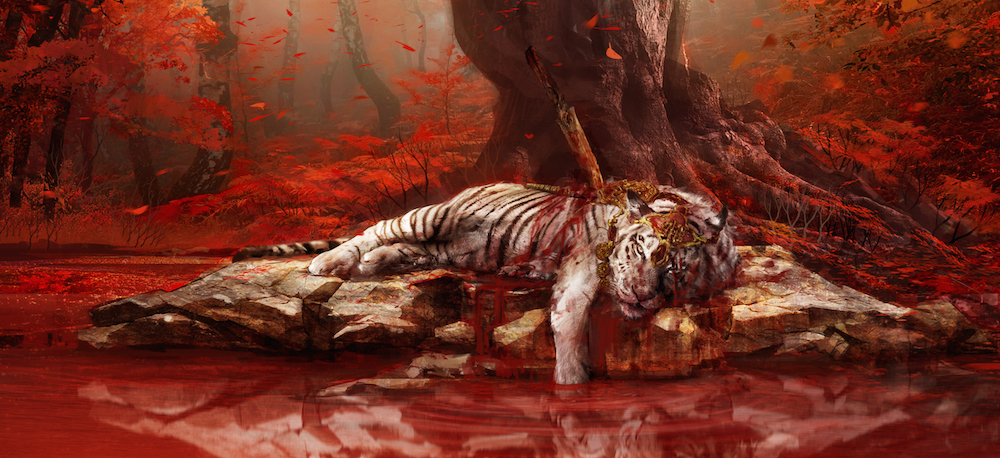‘Here?s a palette, a brush, and a canvas. Go wild.’
Think back on Far Cry 3. Reflect on all the memorable moments you had with that game. What sticks out the most? The missions or the unscripted stuff that happened in the open world?
Chances are you primarily remember the unscripted stuff, mostly due to these moments being wholly unique to just you. Everyone got to experience the missions the same, but it was those open-world encounters that were special because they only happened to you.
With Far Cry 4, the team is looking to make it so the missions themselves are just as memorable as the open world. Mark Thompson is the narrative director on Far Cry 4 and he’s the best man suited for this task thanks to his prior role as Far Cry 3‘s level designer.

“As a level designer, I’ve always been a storyteller,” Thompson told Destructoid. “Every time you build an environment it has its own meaning, it has its own purpose, it has a story to tell just through its setting, architecture, and its composition. So for me storytelling is about the world and the environment and the experience that you create for people. The possibilities they create for people inside that environment.
“For me, and especially with something like Far Cry — when we saw from Far Cry 3 that kind of the allure of the open world, the experience that people can have, we looked at the data from Far Cry 3 and we saw what people were doing. We tracked player behavior and we could see people spent just as much time in the open world as they did in the missions and the main story path,” he explained.
“At the start of Far Cry 3’s development we obviously didn’t have that information … so we start writing the story [and] the characters at the same time you start doing paper design for systems and environment. In Far Cry 3, those two things were done in parallel, but without necessarily a lot of time spent on the connection between those two experiences.
“Originally the open world in Far Cry 3 was designed to be something to do between bubbles of mission gameplay. So for 4 it was more about changing the approach to developing everything at the same time with connectivity embedded in everything. So that everything you do in the open world is connected to the things that happen inside missions. The characters that you see in cinematics you see from them, you hear from them, and you can see their impact on the world outside of story moments and outside of missions.”

Thompson doesn’t necessarily like to say they have a story in Far Cry 4. It’s more that they have a big world that you can experience in a variety of ways. They want to leave players enough room to take away their own stories and moments.
“We aren’t doing anything other people haven’t done,” he stated. “I’m not going to tell you we’re going to revolutionize storytelling in games, right? We’re trying to do what we think is going to be best for Far Cry based on what we learned from 3. It’s challenging in an open world to make a story have a through line that resonates, attracts, and motivates people but at the same time have this smorgasbord of distractions. It’s like trying to serve courses at a buffet restaurant [laughs].
“In terms of the story and trying to bridge that divide between what players can do in an open world and what happens inside missions and cinema, for us on FC3 at some point someone coined the phrase ‘Anecdote Factory’ for the open-world experience. You can go in the game and you play for 15 minutes and you leave with two or three stories that you know won’t have happened to anyone else. You were the author, you were the witness, you saw the events happen.”

However, this didn’t really happen with the missions in Far Cry 3. Sure there were a handful of memorable moments, but players weren’t really having conversations about the story because everyone was experiencing the same thing.
“No one had that personal investment, or that excitement you get when everyone is trying to one-up each other with their own stories. So for 4 in terms of the narrative — like I said we’re not redefining or smashing paradigms — but just trying to give people that same ability to take away something personal from missions … The game doesn’t really present choices as it were — it’s really more about consequences. Some decisions you make sometimes more explicitly, sometimes less explicitly — there’s definitely the idea that the choices you make have consequences.
“The theme of the whole game is about the consequences of your actions. I wanted to give the story or the narrative experience that same kind of level of consequence. The choices you made have actions, and they have repercussions. Sometimes good, sometimes bad, sometimes morally ambiguous, but all the same, two people are going to meet and talk about a mission and not even realize they were both having a different experience.”
It’ll be interesting to see how this unfolds given that there’s still a linear story in place. The people you meet in the course of the game seem to have an impact on how events unfold for players, but I just hope it’s more than granular good or bad choices.
“It’s just about trying to engage people,” Thompson noted at the end of our discussion. “Rather than us say ‘This story is absolute, you must follow it. Connect these dots and it will paint a perfect picture.’ It’s more like ‘Here’s a palette, a brush, and a canvas. Go wild.’”


